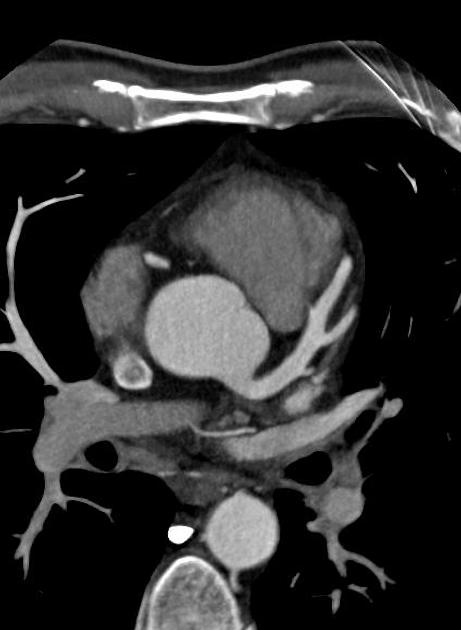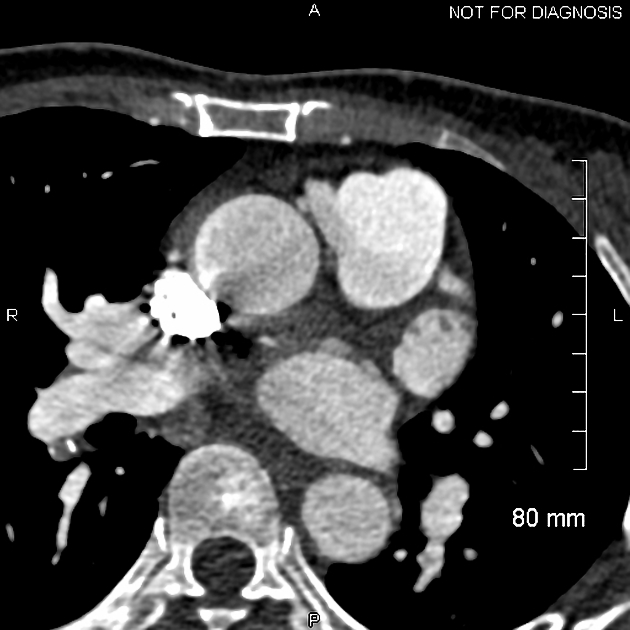Citation, DOI, disclosures and article data
Citation:
Weerakkody Y, Feger J, Silverstone L, et al. Coronary arterial ectasia. Reference article, Radiopaedia.org (Accessed on 17 Feb 2025) https://doi.org/10.53347/rID-40959
Coronary arterial ectasia (CAE) refers to diffuse dilatation of the coronary arteries. Under some classification systems, there is some overlap with the term coronary arterial aneurysms (which is a more focal dilatation) 1.
It is often defined as the dilatation of an arterial segment to a diameter at least 1.5 times (i.e. 150%) that of the adjacent normal coronary artery (unaffected segment) and involves at least 50% or more of the length of the artery 1.
They may be present in up to ~5% (range 3-8%) of angiographic and in ~1% (range 0.2-1.4%) of autopsy series.
Associations
coronary artery disease: co-exists in the great majority of patients
-
inflammatory or connective tissue diseases: 10-20% cases and include
purely congenital in origin in a small proportion of cases
Etiology
It is attributed to atherosclerosis in 50% of patients while in ~25% of patients it may be congenital in origin such as in the setting of a coronary artery-to-pulmonary artery fistula.
Classification
One method of classification is 1:
type I: diffuse ectasia of two or three vessels
type II: diffuse ectasia of one vessel and localized disease in other, i.e. an aneurysm
type III: diffuse ectasia in only one vessel
type IV: focal coronary aneurysm in one vessel
History and etymology
Aneurysmal dilation of coronary arteries was first described by the French surgeon Charles Bougon in 1812 7-9. After several case reports of coronary aneurysms, a more widespread dilatation of the coronary arteries was described and discussed by the American physicians Maurice Packard and HF Wechsler in 1929 10, and later by the American cardiologist Salvador Trinidad and his colleagues in 1953 11.
The terms coronary aneurysm and coronary ectasia were used then interchangeably for many years until more recently 1 when the distinction was made between coronary aneurysm as a more focal dilation and coronary ectasia for more diffuse dilation of the coronary arteries 1,9,12.
-
1. Díaz-Zamudio M, Bacilio-Pérez U, Herrera-Zarza M et al. Coronary Artery Aneurysms and Ectasia: Role of Coronary CT Angiography. Radiographics. 2009;29(7):1939-54. doi:10.1148/rg.297095048 - Pubmed
-
2. Gunes Y, Boztosun B, Yildiz A et al. Clinical Profile and Outcome of Coronary Artery Ectasia. Heart. 2006;92(8):1159-60. doi:10.1136/hrt.2005.069633 - Pubmed
-
3. Manginas A & Cokkinos D. Coronary Artery Ectasias: Imaging, Functional Assessment and Clinical Implications. Eur Heart J. 2006;27(9):1026-31. doi:10.1093/eurheartj/ehi725 - Pubmed
-
4. Aboeata A, Sontineni S, Alla V, Esterbrooks D. Coronary Artery Ectasia: Current Concepts and Interventions. Front Biosci (Elite Ed). 2012;4(1):300-10. doi:10.2741/377 - Pubmed
-
5. Ramappa P, Kottam A, Kuivanemi H, Thatai D. Coronary Artery Ectasia--Is It Time for a Reappraisal? Clin Cardiol. 2007;30(5):214-7. doi:10.1002/clc.20002 - Pubmed
-
6. Chakrabarti S, Thomas E, Wright J, Vettukattil J. Congenital Coronary Artery Dilatation. Heart. 2003;89(6):595-6. doi:10.1136/heart.89.6.595 - Pubmed
-
7. Jarcho S. Bougon on Coronary Aneurysm (1812). Am J Cardiol. 1969;24(4):551-3. doi:10.1016/0002-9149(69)90500-1 - Pubmed
-
8. Bougon Charles JJ. Observations sur un aneurisme d’une des
arteries coronaires ou cardiaques. Bibliothèque Médicale, 37: 85-90, 1812.
-
9. Kawsara A, Núñez Gil I, Alqahtani F, Moreland J, Rihal C, Alkhouli M. Management of Coronary Artery Aneurysms. JACC Cardiovasc Interv. 2018;11(13):1211-23. doi:10.1016/j.jcin.2018.02.041 - Pubmed
-
10. Packard M. Aneurysm of the Coronary Arteries. Arch Intern Med. 1929;43(1):1. doi:10.1001/archinte.1929.00130240004001
-
11. Trinidad S, Grayzel D, Rapoport P. Aneurysm of the Coronary Artery. Ann Intern Med. 1953;39(5):1117. doi:10.7326/0003-4819-39-5-1117 - Pubmed
-
12. Luo Y, Tang J, Liu X et al. Coronary Artery Aneurysm Differs From Coronary Artery Ectasia: Angiographic Characteristics and Cardiovascular Risk Factor Analysis in Patients Referred for Coronary Angiography. Angiology. 2016;68(9):823-30. doi:10.1177/0003319716665690 - Pubmed
Promoted articles (advertising)






 Unable to process the form. Check for errors and try again.
Unable to process the form. Check for errors and try again.